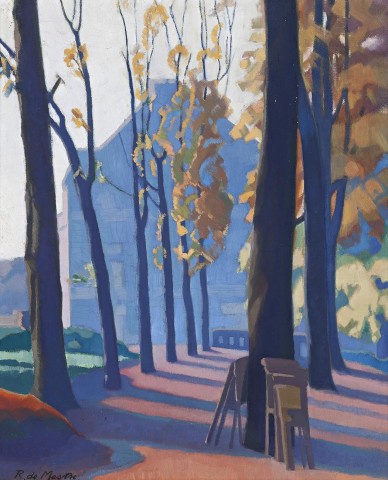PAYSAGE AUTOMNE (IN THE LUXEMBOURG GARDENS), 1923
ROY DE MAISTRE
oil on canvas on board
46.0 x 38.0 cm
signed lower left: R de Mestre.
signed and inscribed with title verso: 30 2 Paysage Automne / 13 / R de Mestre
bears inscription verso: Mrs McCall
Macquarie Galleries, Sydney
Miss Jean Thomson
Private collection
Sotheby’s, Melbourne, 14 August 1989, lot 309 (as ‘Paysage Automne (In the Luxembourg Gardens, Paris)’)
Ken and Joan Plomley Collection of Modernist Art, Melbourne
Australian Artists in Europe: Exhibition of Paintings and Sculpture, The Faculty of Arts Gallery, London, 23 June – 12 July 1924, cat. 59 (as ‘Automne, Jardin du Luxembourg’)
Oil Paintings by Roi de Mestre, Macquarie Galleries, Sydney, 6 – 17 April 1926, cat. 13 (as ‘In the Luxembourg Gardens’)
‘Art Exhibition: Mr. De Mestre’s Paintings.’, Sydney Morning Herald, Sydney, 6 April 1926, p. 12 (as ‘In the Luxembourg Gardens’)
Art in Australia, Sydney, third series, no. 16, 1 June 1926, p. 17 (illus. as ‘In the Luxembourg Gardens’)
Johnson, H., Roy de Maistre: The Australian Years 1894 – 1930, Craftsman House, Sydney, 1988, fig. 9, p. 69 (illus., as ‘In the Luxembourg Gardens’)
Ingram, T., ‘Art Market’, Art and Australia, Sydney, vol. 27, no. 2, Summer 1989, p. 292 (illus. as ‘Paysage Automne (In the Luxembourg Gardens, Paris)’)
The Luxembourg Gardens are one of the centres for leisure in Paris. Sited next to the Luxembourg Palace, the Gardens comprise twenty-five acres of formal plantings, trees, fountains and statuary bisected by multiple gravel paths and grassed lawns. Originally created on the initiative of Queen Marie de Medici in 1612, their central location and extensive diversions make them a magnet for families and tourists. Not surprisingly, they have also attracted artists such as Jacques-Louis David, Henri Matisse and Vincent van Gogh; and Australians including Kathleen O’Connor, and Ethel Carrick Fox. Away from the delighted squeal of children riding the ancient carousel or laughing at a puppet show, and the soft ‘donk’ of pétanque balls hitting the gravel, the Gardens are also rich in quiet, contemplative nooks, places of dappled sunlight and shadow. In Paysage Automne (In the Luxembourg Gardens), 1923, Roy de Maistre gives us one such vista, a view of the palace’s side wing seen through a silent colonnade of leafy trees.
De Maistre first visited France in the autumn of 1923, after arriving in London following his award of the Society of Artists’ Travelling Scholarship. Disappointed with London, its light and its relatively listless local art scene, he travelled on to Paris where he exhibited one work in the 1924 Société Nationale des Beaux Arts. He also visited other French locations – Arles, Compiègne and St. Jean de Luz – and took a side trip to Spain (see lot 5 Bridge in Spain (Alcántara Bridge, Toledo)). During this extended period, he painted ceaselessly, building continuously on the skills he had developed during his previous years in Australia. He was also able to examine the work of master artists in the flesh for the first time, particularly van Gogh and Paul Cézanne, both of whose influence may be perceived in Paysage Automne (In the Luxembourg Gardens). There is also the echo of the earlier and equally influential Barbizon School whose artists were among the first to take their easels outside and capture their landscapes en plein air.
As its title suggests, the painting was created in the northern hemisphere’s autumn months (September to December). The crisp morning light is reminiscent of one of The Art Gallery of New South Wales’ most popular purchases in the years before de Maistre’s departure, Elioth Gruner’s Spring Frost, 1919. It is highly probably that he was familiar with Gruner’s depiction of chilled cows illuminated at the edges by the rising sun. Against one trunk in Paysage Automne (In the Luxembourg Gardens) is a small stack of the Gardens’ collection of folding ‘Simplex’ chairs. The shadows of the trees fall in ordered rows across the gravel and in the background, the looming masonry of the Palace is rendered in cool tones of grey-blue. De Maistre, it would seem, empathised with the underlying concept that the Gardens are a cultivated environment, one which reflects that very French sensibility of an experience directed at the taming and ordering of nature in the interests of humanity. Paysage Automne (In the Luxembourg Gardens) stands as a wonderfully harmonious image on its own, full of rich colour in spite of its subdued tenor, demonstrative of an artist in absolute control of his medium.
ANDREW GAYNOR
